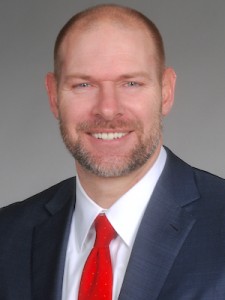 Four months ago, a new type of infrastructure company was born in the form of Communications Sales & Leasing, which was spun off from Windstream as the industry’s first communications REIT. Since then, just what CS&L will do next has been the first question people generally ask of me. Will they start acquiring assets, and if so, of what type? And what does it mean to be a network REIT in the first place? To answer such questions, I thought I’d go straight to the source. So with us today to talk about the company and his vision of its future is CS&L CEO Kenny Gunderman.
Four months ago, a new type of infrastructure company was born in the form of Communications Sales & Leasing, which was spun off from Windstream as the industry’s first communications REIT. Since then, just what CS&L will do next has been the first question people generally ask of me. Will they start acquiring assets, and if so, of what type? And what does it mean to be a network REIT in the first place? To answer such questions, I thought I’d go straight to the source. So with us today to talk about the company and his vision of its future is CS&L CEO Kenny Gunderman.
TR: Let’s start with the basics. Which assets of Windstream does CS&L own now, and what did Windstream retain in the spinoff?
KG: We own the actual last mile fiber and copper, the metro fiber, fiber to the tower, and some of the longhaul fiber. It’s 3.6M strand miles of fiber and about 235,000 route miles of copper. We also own some land and buildings and colocation facilities, but the vast majority of the value is the fiber. Windstream still owns all of the equipment and electronics, they continue to own the customer relationship, the regulatory obligations and generally speaking all of the obligations of the business as they were the day before the spinoff. Nothing changed about their day-to-day operating business; it’s really just that the underlying fiber and copper is owned by CS&L.
TR: Networks aren’t static of course, so what happens when Windstream wants to augment its network? Who builds, finances, and owns it?
KG: Windstream can come to us ask us to finance a new fiber build in Little Rock or Des Moines or wherever. We can do that for them and the asset becomes ours, leased back to Windstream on an exclusive basis. In fact, for 2015 Windstream has requested that we fund $50M of fiber-to-the-tower, fiber-to-the-home, and other metro fiber projects and we have agreed. We haven’t funded that yet, but we will sometime this year. And going forward, we really want to do that for other customers as well. I think that’s a compelling part of our business proposition.
Otherwise, if Windstream decides to pay for and build a brand new fiber route or loop that doesn’t overbuild our current network, then that is Windstream’s asset. However, if Windstream decides to overbuild our copper with fiber, then regardless of who pays for it that fiber becomes part of our asset base as a tenant capital improvement. That last part is a nuance that a lot of people don’t understand about us.
TR: How important is it to CS&L to make further acquisitions of infrastructure assets?
KG: It is very, very important to us. Right now, Windstream is our only customer and we want to diversify. They’re a great customer and we like the trajectory of their business, but having no diversification is not where we want to be. So we very much want to make acquisitions and add assets and customers. And personally, looking for new customers, acquisitions, or assets to acquire, is where I spend the vast majority of my time currently.
TR: What type of assets is CS&L interested in acquiring?
KG: Fiber is definitely a focus, whether it is fiber-to-tower, metro fiber, enterprise, fiber-to-the-home, or longhaul. We’re not opposed to copper, but there’s a higher standard. In order for us to make copper acquisitions there needs to be a good business plan that will generally include overbuilding the copper with fiber or some other way to greatly enhance speeds. We’re also looking at data centers, and we’re looking at towers as well. We’re not looking to compete with American Tower or Crown Castle, but there are still some unique opportunities for us there. Other assets of interest include rights of way, ground leases, and HFC footprints. The entire spectrum of critical telecom infrastructure is of interest to us.
TR: You mentioned HFC, do you think there is interest from cable operators to sell and lease back their footprints?
KG: Absolutely. We’ve had enough conversations to know there is an opportunity there for us. But we definitely haven’t had the same depth of conversations there yet as we have on the traditional telecom side. It’s really a function of the fact that we’ve only been public for four months, and we haven’t had time to get out to those guys. But we definitely plan to.
TR: One other thing I’ve heard you mention recently is that CS&L is open to buying an operating company in addition to following the triple-net-lease model. Might you use such an acquisition as a consolidation platform?
KG: I think a fiber operating platform could be interesting to us as an acquisition rollup vehicle, but also as a way for us to deploy our capital organically. I mentioned financing capital builds for others, but there’s absolutely no reason we couldn’t do that for ourselves if we had the right platform. There are a lot of benefits an operating platform might bring, and I think eventually you’ll see that from us. Having said that, however, we intend to stay very heavy asset and operations light. If we do have an operating business, it will never be the dominant part of our business.
TR: Is that because of the restrictions imposed by the REIT structure?
KG: It is really more driven by the fact that we really like the triple-net-lease model. There’s a universe of triple-net-lease REITs out there, and we’re one of them. It’s a simpler model and a very high margin business, buying mission critical assets and locking in long term customer relationships, which we think is very conducive to being a yield-oriented security.
TR: What types of network assets and revenues are REITable today? How much of your business has to fall into the right category?
KG: As a REIT we can’t have more than 25% of our asset value or 25% of our cash flow as non-REITable. In terms of assets, the things that are REITable today and supported by private letter rulings are fiber, copper, towers, and data centers, and the related real estate attached to those things – the land, rights of way, buildings, colo huts, etc. Income from dark fiber and colocation are REITable, and lit services are generally REITable although it depends on the standards and contracts. Then, once you start to get into managed services higher in the stack, the income become increasingly less REITable.
TR: EBITDA multiples vary widely across different types of infrastructure businesses, do you think any sectors are underpriced or overpriced today?
KG: I think the assets and valuations are very much case specific. The attractiveness varies across opportunities and situations more so than it does across asset classes.
TR: Your EBITDA margin in your first partial quarter was 95%, is that level what we should expect from CS&L going forward or do you expect acquisitions to bring it down?
KG: I think so. You may see deals where the specific opportunity may have lower margins, but on a blended basis you should still expect to see our margins around that level. It’s a little bit high even for triple-net lease REITs, so there’s room for it to come down and still be in line with our REIT peers.
TR: What size are the possible acquisitions you are looking for currently? Would something of similar size to the Windstream assets be too much at this stage?
KG: Were looking at sizes across the board, but fresh off our spinoff a Windstream-sized deal is unlikely just from a tax perspective. We’re not pursuing transactions of that size just yet, although I do think they’re out there.
TR: How do you think being the first communications REIT affect the market’s perception of the company?
KG: I think, on the one hand, it’s great to be the first of our kind, and it does give us some advantages. But it also causes some people to put us in the category of new and complex. The reality is that our business model and what we can do for carriers is not complex, and I think that message is starting to resonate. It’s very analogous to a dark fiber IRU. We own the underlying asset, but we’re leasing it to customers for long periods of time – 10, 15, 20 years.
TR: Thank you for talking with Telecom Ramblings!
If you haven't already, please take our Reader Survey! Just 3 questions to help us better understand who is reading Telecom Ramblings so we can serve you better!
Categories: Fiber Networks · Industry Spotlight · Mergers and Acquisitions





Any thoughts on the unfavorable market reaction?
I think its still too early to tell. The markets are jittery enough that investing in a new, poorly understood model like CSAL is going to be a hard sell no matter what.
Once an entity qualifies to be a REIT (generally, being in the business of owning certain types of assets rather than providing services), doesn’t it thereby strip itself of the protections offered by the federal pole attachment rules, which apply only to cable TV companies and telecommunications SERVICE PROVIDERS? I would think CS&L would be exposed, for example, to unregulated attachment rental fees.
Is it supposed to read 2015 for the funding comment? Just curious since it’s Sept already. Would that be reflected in WIN reporting already if agreed to? Just in time for y/e bonuses.